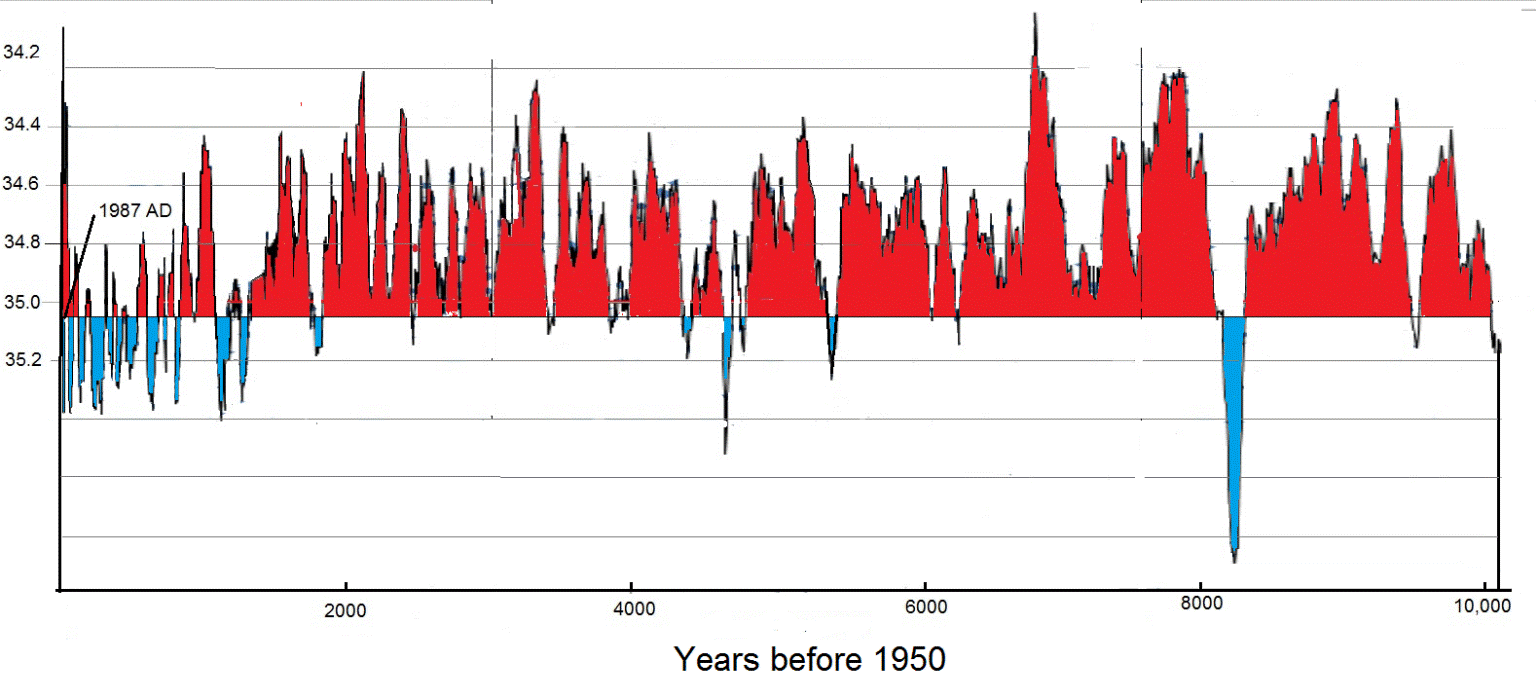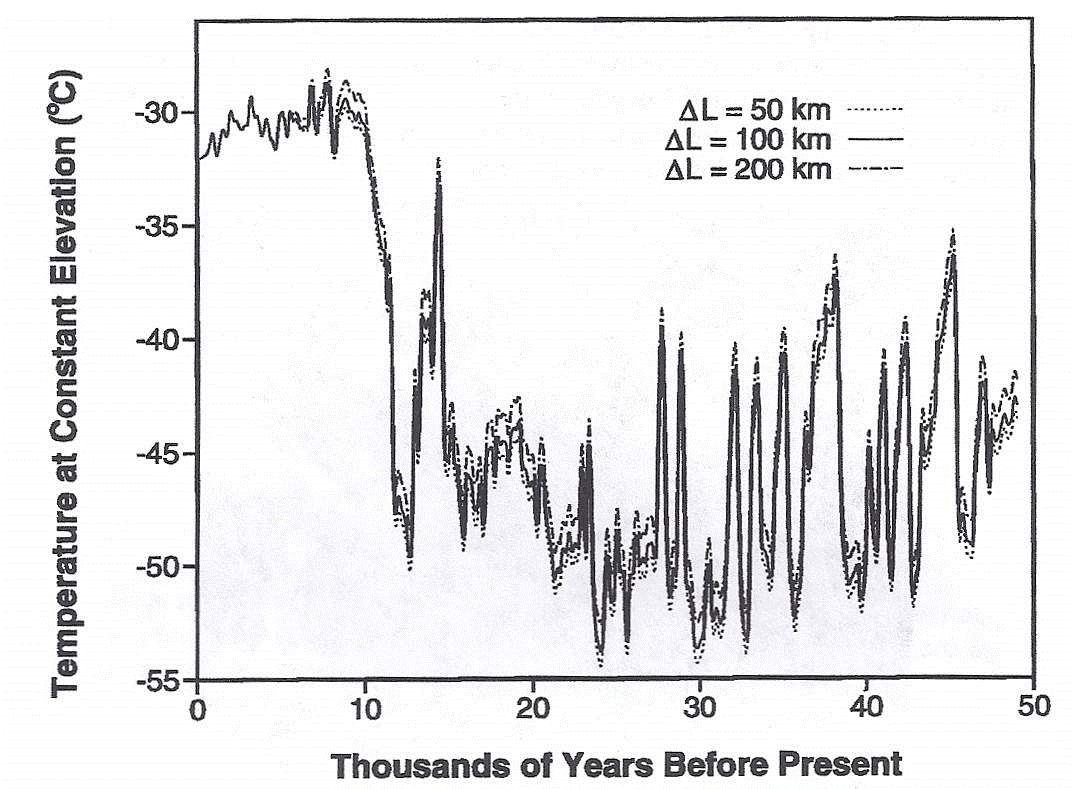By Don J. Easterbrook
Professor of Geology, Western Washington Univ, Bellingham, WA
A fundamental axiom in geology is “The present is the key to the past,” i.e. in order to understand past geologic phenomena we need to understand present-day processes. We can also turn this adage around to say “The past is the key to the future,” i.e., in order to predict the future we need to know what has happened in the past. With that in mind, looking at temperature changes over the past millennia is very instructive about the nature of climate changes. Among the various ways of reconstructing past climates is the oxygen isotope record preserved in cores of the Greenland and Antarctic ice sheets.
Variation of oxygen isotopes in ice cores is a measure of temperature fluctuations. Most atmospheric oxygen consists of 16O but a small amount consists of 18O, an isotope of oxygen that is somewhat heavier. When water vapor (H2O) condenses from the atmosphere as snow, it contains a ratio of 16O/18O (δ18O) that reflects the temperature at the time. When the snow falls on a glacier and is converted to ice, it retains an isotopic ‘fingerprint’ of the temperature conditions at the time of condensation. Measurement of the 16O/18O ratios in glacial ice hundreds or thousands of years old allows reconstruction of past temperature conditions. Thousands of accelerator measurements of δ18O from the Greenland GISP2 ice core made by Stuiver and Grootes at the University of Washington can be used to reconstruct temperature fluctuations in Greenland over the past 100,000 years (Stuiver and Grootes, 2000;. Grootes and Stuiver, 1997; Stuiver et al.., 1995; Stuiver, et al., 1993). What makes these measurements so useful is the accuracy of dating of the samples accomplished by counting annual layers of dust that accumulated in the ice during each melt season on the glacier, giving a dating accuracy of a few years over thousands of years. This is not possible in the Antiarctic ice cores.
Although the GISP2 ice core data is site specific (Greenland), it has been well correlated with global glacial fluctuations and a wide range of other climate proxies and has become the ‘gold standard’ among global climate reconstructions. However, keep in mind that temperature variations are latitude specific so actual temperatures from the GISP2 cores show a higher range of values than global data. The GISP2 cores date back 100,000 years, but we will focus here on data from the past 10,000 years (the Holocene) and compare it with recent warming and cooling periods.
The GISP2 temperature data includes two types: (1) oxygen isotope measurements (δ18O) that reflect temperatures at the time of snow accumulation, and (2) borehole temperature measurements that allow reconstruction of temperatures in degreees.
Oxygen isotope measurements (δ18O)
Figure 1 shows δ18O from the GISP2 ice core for the past 10,000 years. The isotope record begins at 1987 AD at the top of the core. Temperatures higher than those in 1987 (the horizontal line) are shown in red, lower in blue. The most striking thing about the curve is that temperatures for almost all of the 10,000 year record were higher than those in 1987. The last 1500 years or so were cooler. Thawing out has occurred since the Little Ice Age, but temperatures are not yet back to where they had been for almost all of the Holocene.

Figure 1. δ18O from the GISP2 ice core for the past 10,000 years. Red areas represent temperatures warmer than those in 1987 (top of the core); blue areas were cooler. Almost all of the past 10,000 years were warmer than the past 1500 years. (Plotted from data in Grootes and Stuiver, 1997)
Greenland temperatures since 1987
The top of the GISP2 core was 1987 so in order to compare temperatures in recent decades with the isotope temperatures for the past 10,000 years, we need to know what Greenland temperatures have been since then. Chylek et al. (2004) analyzed temperature histories of coastal stations in southern and central Greenland having almost uninterrupted temperature records between 1950 and 2000 and found that coastal Greenland’s peak temperatures occurred between 1930 and 1940, after which subsequent decrease in temperature was so substantial and sustained that current coastal temperatures „are about 1°C below their 1940 values.“ „At the summit of the Greenland ice sheet, the summer average temperature has decreased at the rate of 2.2°C per decade since the beginning of the measurements in 1987.“ Chylek et al. found that during the Greenland warming of the 1920s (Figure 2) „average annual temperature rose between 2 and 4°C (and by as much as 6°C in the winter) in less than ten years.“ They called this the “great Greenland warming of the 1920s,” and concluded that „since there was no significant increase in the atmospheric greenhouse gas concentration demonstrates that a large and rapid temperature increase can occur over Greenland, and perhaps in other regions of the Arctic, due to internal climate variability … without a significant anthropogenic influence.“

Figure 2. Arctic temperatures from 1880 to 2004. Note the very steep warming in the 1920s and that temperatures in the 1930s were warmer than in 2004. (From Jones et al. data set)
Figure 3 shows temperature variations at 8 Greenland stations. Note that although post-2000 temperatures have risen, they don’t exceed those of the 1930s.

Figure 3. Greenland temperature variations since 1880 at eight stations.
Annual five-year average temperatures from 1995 to 2005 for 8 stations in Greenland were similar to 1920 to 1930 temperatures but did not exceed them (Figure 4).

Figure 4. Annual five-year average temperatures from 1900 t0 2005 for 8 stations in Greenland. Temperatures during 1995-2005 were similar to 1920–1930 but did not exceed them. (Chylek et al., 2006).
Two weather stations, Godthab Nuu and Angmagssalik on opposite coasts of Greenland, have the longest records, dating back more than a century. Both show similar annual temperature patterns—strong warming in the 1920s and 1930s followed by cooling from 1950 to 1980 and warming from 1980 to 2005. With the exception of 2003 at one station, recent temperatures are only at mid-20th century levels.
The significance of these recent temperature records is that they show that temperatures in the past several decades have not exceeded those of the 1930s, so the 1987 δ18O values may be used for comparison of recent temperatures with those of the past 10,000 years, i.e., about 85% of the past 10,000 years were warmer than the present.
GISP2 temperature reconstructions
A second approach to determination of temperature reconstruction of Greenland from the GISP2 core was the use of borehole temperature logs, corrected for temperature probe response times, thermal disturbances from the drilling process and fluid convention in the borehole, by Cuffy and Clow (1997) (Figure 5) and Alley (2000) (Figure 6). The curve generated by Alley (2000) shows that temperatures were significantly warmer during about 8,500 of the past 10,000 years.

Figure 5. Cuff and Clow (1997) temperature reconstruction of the GISP2 Greenland ice core.

Figure 6. Alley (2000) temperature reconstruction of the GISP2 Greenland ice core. (Plotted from data in Alley, 2000)
Some confusion has occurred concerning the starting point of the Alley curve. The archived NOAA database says the “PERIOD OF RECORD: 49 KYrBP – present.” Since this was in a 2000 publication, some (including me) took ‘present’ to mean 2000. But other possibilities include 1987 (the top of the core) or 1950, which occurs 20 meters below the top of the core. Apparently, 1950 was used as ‘Present, so the first data point on the Alley curve (95 years) means that there is a 164 year hiatus between the first data point and 2014. This poses a problem for assessing the relationship between Greenland temperatures in recent decades and the 10,000 year GISP2 record, i.e., were 8,500 years of the past 10,000 years warmer than recent decades? Fortunately, we can use the δ18O record for the missing interval, as well as measured temperature records from Greenland weather stations. Figure 7 shows the δ18O curve for 1850-1987 AD.

Figure 7. δ18O curve for 1850 to 1987. Note that the first Alley (2000) data point falls exactly on the same timeline as the top of the core (1987). Thus, there is no temperature difference between the first data point in Alley (2000) and the top of the core.
Temperatures since 1987 have been discussed above (see figures 2,3,4), showing that temperatures in recent decades have not exceeded those in the 1930s, so the 1987 timeline can be used for comparison with temperatures over the past 10,000 years.
Conclusions
Oxygen isotope measurements of the GISP2 ice core show that about 8,500 of the past 10,000 years were significantly warmer than recent decades. The most recent 1 500 years, including the Little Ice Age were cooler. Temperature reconstructions from borehole data confirm the oxygen isotope data and show that about 8,500 of the past 10,000 years were significantly warmer than recent decades. Temperature measurements at eight Greenland weather stations show that temperatures in recent decades have not exceeded 1930s levels, so top-of-core data (1987) may be compared to paleo-temperatures over the past 10,000 years.



